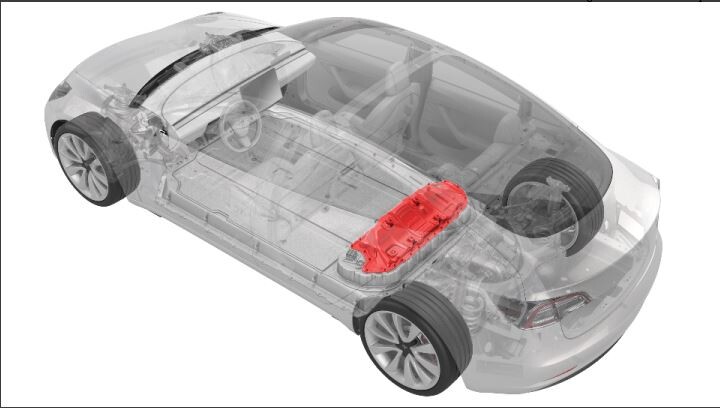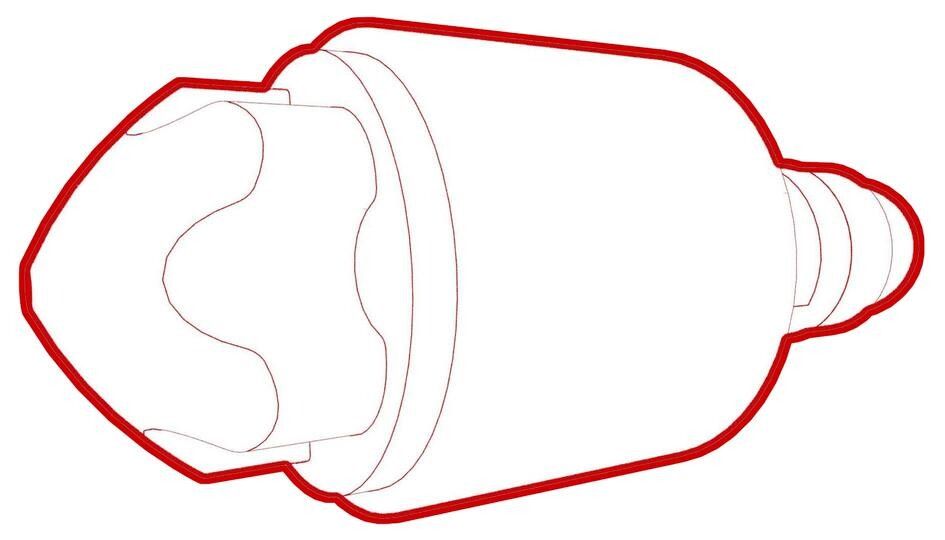Cover - Ancillary Bay (Remove and Replace)
 Correction code
16101002
1.08
NOTE: Unless otherwise explicitly
stated in the procedure, the above correction code and FRT reflect all of the work
required to perform this procedure, including the linked procedures. Do not stack correction codes unless
explicitly told to do so.
NOTE: See Flat Rate
Times to learn more about FRTs and how they are created. To provide feedback on
FRT values, email ServiceManualFeedback@tesla.com.
NOTE: See Personal Protection to make sure wearing proper PPE when
performing the below procedure. See Ergonomic Precautions for safe and healthy working practices.
Correction code
16101002
1.08
NOTE: Unless otherwise explicitly
stated in the procedure, the above correction code and FRT reflect all of the work
required to perform this procedure, including the linked procedures. Do not stack correction codes unless
explicitly told to do so.
NOTE: See Flat Rate
Times to learn more about FRTs and how they are created. To provide feedback on
FRT values, email ServiceManualFeedback@tesla.com.
NOTE: See Personal Protection to make sure wearing proper PPE when
performing the below procedure. See Ergonomic Precautions for safe and healthy working practices.
- 2025-10-13: Added warning at step to remove/install the ancillary bay cover to do this while standing outside the vehicle.
- 2024-07-29: Added information on installing a recycling warning label with CE marking and manufacturer information, if this was present on the ancillary bay cover being replaced.
- 2024-04-04: Added information on installing and removing acillary bay kit insulators.
- 2023-11-08: Added/updated HV insulating glove steps.
- 2023-06-09: Corrected paint pen colors.
- 2023-05-22: Added caution for correct positive DC cable connection.
- 1127845-00-A Asy, Service Cover, Penthouse, Model 3
- 1059330-00-B Skt, 1/4in Dr, 5-Lobe Torx Plus External
- 1076971-02-A Wrench, Torque + Angle, 1/4" Dr
- 1108272-00-B Cap, Logic Conn, Inv, 3DU
- 1108781-BB-F: LABEL - RECYCLING WARNING - EU
Only
technicians who have completed all required certification courses are permitted to
perform this procedure. Tesla recommends third party service provider technicians
undergo equivalent training before performing this procedure. For more information on
Tesla Technician requirements, or descriptions of the subject matter for third parties,
see HV Certification Requirements. Proper personal protective equipment (PPE) and insulating HV
gloves with a minimum rating of class 0 (1000V) must
be worn at all times a high voltage cable, busbar, or fitting is handled. Refer to Tech Note TN-15-92-003, High Voltage Awareness
Care Points
for additional safety
information.
Torque Specifications
| Description | Torque Value | Recommended Tools | Reuse/Replace | Notes |
|---|---|---|---|---|
| Nut that attaches the positive 12V output cable to the DCDC passthrough |
 15 Nm (11.1 lbs-ft) |
|
Replace |
Note
Mark the fastener with a
paint pen after torquing.
|
| Bolt that attaches the ancillary bay cover to the high voltage controller |
 5 Nm (3.7 lbs-ft) +30 deg |
|
Reuse | |
| Bolt attaches the ancillary bay cover to the HV battery |
 8 Nm (5.9 lbs-ft) |
|
Reuse |
CAUTION Use an External Torx E10 5-Lobe socket that is not magnetized. Sockets with magnets will not fully grip and can possibly strip the bolt head. Note Torque these fasteners in the sequence specified in the installation step. Note These bolts are attached to the ancillary bay cover. |
Remove
- Remove the 2nd row lower seat cushion. Seat Cushion - Lower - 2nd Row (Remove and Replace).
- Remove the RH 2nd row seat back. See Seat Back - 2nd Row - RH (Remove and Replace).
- Remove the LH 2nd row seat back. See Seat Back - 2nd Row - LH (Remove and Replace).
- Disconnect 12V power. See 12V/LV Power (Disconnect and Connect).
-
Disconnect the electrical harness from the high voltage controller connector.
NoteThe HV battery positive contactor and negative contactor open with a clunk sound.
-
Install the logic connector cap onto the high voltage controller connector to prevent mistaken reconnection and protect the connector.
- Perform Vehicle HV Disablement Procedure. See Vehicle HV Disablement Procedure.
- If the leather over gloves have been removed, inspect the inner edge of the vehicle single-piece rear casting for flashing. If flashing is present, put on cut-resistant gloves.
- Release the cover on the positive 12V output cable, at the DCDC passthrough.
-
Remove the nut that attaches
the positive 12V output cable to the DCDC passthrough, and then remove the
cable from the passthrough.
NoteInspect the condition of the rubber boot at the end of the output cable, and replace the boot if it is melted or damaged.
-
Remove and discard the bolts that attach the high voltage controller internally to the ancillary bay cover.
TIpUse of the following tool(s) is recommended:
- External Torx E10
- 4 in extension
- Ratchet/torque wrench
- Torque wrench with angle measurement
Figure 1. 4-Bolt HVC Ancillary Bay Cover Figure 2. 3-Bolt HVC Ancillary Bay Cover -
Put on HV insulating gloves and leather over gloves.
WarningContinue to wear the gloves until instructed to remove them.
-
Fully loosen the bolts that attach the ancillary bay cover to the HV battery.
CAUTIONUse an External Torx E10 5-Lobe socket that is not magnetized. Sockets with magnets will not fully grip and can possibly strip the bolt head.NoteThe bolts are captive to the ancillary bay cover.TIpUse of the following tool(s) is recommended:
- External Torx E10 5-Lobe
- 4 in extension
- Ratchet/torque wrench
-
Remove the logic connector cap from the high voltage controller connector.
-
Remove the ancillary bay cover from the vehicle.
WarningRemove the ancillary bay cover from the vehicle while standing outside the vehicle to reduce the risk of falling into the open HV battery.
-
Reinstall the logic connector cap onto the high voltage controller connector.
- Inspect whether HV insulators are present. If not present or partly present, use the Ancillary Bay Insulator kit and install the insulator caps onto the HV battery to cover live HV points. See Insulators - HV Battery (Install and Remove).
-
Visually inspect the interior of the ancillary bay for any presence of leaked coolant.
NoteAreas of interest are the coolant input and output tubes and fittings, and around the perimeter of the ancillary bay.CAUTIONIf any leaked coolant is found, escalate a Toolbox session.
-
Visually inspect the condition of the ancillary bay cover gasket and the HV battery mating surface for cracks, cuts, gouges, abrasions, or any damage that could affect the seal.
NoteIf the damage to the gasket is severe, replace the ancillary bay cover. If there is minor damage (including paint) that might affect the seal, perform an ancillary bay air leak test when instructed to do so.
Install
-
For Europe only: Check the ancillary bay cover that is being replaced for the presence of a recycling warning label that includes a CE marking and manufacturer information.
- If the recycling warning label with CE marking and manufacturer information is not present on the ancillary bay cover being replaced, continue to the next step.
- If the recycling warning label with CE marking and manufacturer information is present on the ancillary bay cover being replaced:
- Note the area where the recycling warning label is affixed on the ancillary bay cover being replaced.
- Clean the corresponding area on the new ancillary bay cover with an IPA wipe and allow 1 minute dry time.
- Install a new recycling label with CE marking and Manufacturing Information (part number 1108781-BB-F) on the new ancillary bay cover.
-
If the old ancillary bay cover has
volcano brackets, and the replacement ancillary bay cover does not have the same brackets,
rework the High Voltage Controller (HVC) as required to achieve proper fitment between the
replacement cover and HVC. If the replacement cover has volcano brackets, skip to the next
step in this procedure.
Figure 3. Replacement ancillary bay cover without volcano brackets Figure 4. Ancillary bay cover rework area; Cover shown installed for clarity Figure 5. HVC standoff to be removed; Ancillary bay cover shown removed for clarity - Use IPA wipes to clean the ancillary bay cover gasket surface, and the mating surface of the HV battery.
- Use an IPA wipe to clean any residue from the high voltage controller mounting bolt holes and both the inside and outside of the ancillary bay cover at the bolt holes.
-
If the aluminum tape retrofit patch is missing or damaged, remove the patch (if present), clean the area with an IPA wipe, apply another patch of aluminum tape, and wet out the patch with a silicone roller to set the adhesive.
TIpUse of the following tool(s) is recommended:
- 3M 425 Aluminum Foil Tape - 0601363
Figure 7. 5-Bolt to 4-Bolt Patch 50mm x 50mm Figure 8. 4-Bolt to 3-Bolt Patch 30mm x 30mm - Inspect the inner edge of the vehicle single-piece rear casting for metal flashing. If flashing is present and the leather over gloves have been removed, put on cut-resistant gloves.
-
Remove the logic connector cap from the high voltage controller connector.
- Remove all insulator kit covers from the HV battery. See Insulators - HV Battery (Install and Remove).
-
Install the ancillary bay cover on the HV battery, and then hand-tighten the bolts.
WarningInstall the ancillary bay cover to the HV battery while standing outside the vehicle to reduce the risk of falling into the open HV battery.
- Remove HV insulating gloves.
-
Reinstall the logic connector cap onto the high voltage controller connector.
-
Torque the ancillary bay cover bolts in the sequence shown, and mark each with an orange paint pen as they are torqued.
 8 Nm (5.9 lbs-ft)CAUTIONUse an External Torx E10 5-Lobe socket that is not magnetized. Sockets with magnets will not fully grip and can possibly strip the bolt head.TIpUse of the following tool(s) is recommended:
8 Nm (5.9 lbs-ft)CAUTIONUse an External Torx E10 5-Lobe socket that is not magnetized. Sockets with magnets will not fully grip and can possibly strip the bolt head.TIpUse of the following tool(s) is recommended:- External Torx E10 5-Lobe
- 4 in extension
- Ratchet/torque wrench
Figure 9. 18-Bolt Ancillary Bay Cover Torque Sequence -
Hand-tighten new bolts that attach the high voltage controller internally to the ancillary bay cover.
Figure 10. 4-Bolt HVC Ancillary Bay Cover Figure 11. 3-Bolt HVC Ancillary Bay Cover -
Torque the high voltage controller to ancillary bay cover bolts in the sequence shown, and mark each bolt with an orange paint pen as they are torqued.
 5 Nm (3.7 lbs-ft) +30 degCAUTIONInsufficient torque of bolts 1 and 2 opens the high voltage interlock loop circuit.TIpUse of the following tool(s) is recommended:
5 Nm (3.7 lbs-ft) +30 degCAUTIONInsufficient torque of bolts 1 and 2 opens the high voltage interlock loop circuit.TIpUse of the following tool(s) is recommended:- External Torx E10
- 4 in extension
- Ratchet/torque wrench
- Torque wrench with angle measurement
Figure 12. 4-Bolt HVC Ancillary Bay Cover Figure 13. 3-Bolt HVC Ancillary Bay Cover -
Connect the positive 12V output cable to the DCDC passthrough, install a new nut to attach the cable, and mark the nut with a pink/violet paint pen after torque.
 15 Nm (11.1 lbs-ft)CAUTIONMake sure that the rubber boot is not trapped under the cable lug or pinched between the cable lug and nut.CAUTIONMake sure the positive output cable is positioned properly and in the right direction against the plastic anti-rotation edge on the DCDC passthrough.NoteMark the fastener with a paint pen after torquing.TIpUse of the following tool(s) is recommended:
15 Nm (11.1 lbs-ft)CAUTIONMake sure that the rubber boot is not trapped under the cable lug or pinched between the cable lug and nut.CAUTIONMake sure the positive output cable is positioned properly and in the right direction against the plastic anti-rotation edge on the DCDC passthrough.NoteMark the fastener with a paint pen after torquing.TIpUse of the following tool(s) is recommended:- 13 mm 12-point deep socket
- 3 in extension
- Ratchet/torque wrench
- If removed, replace the cover on the positive 12V output cable at the DCDC passthrough, and then press down to attach the cover.
-
Remove the logic connector cap from the high voltage controller connector.
-
Connect the electrical harness to the high voltage controller connector.
- If damage was found on the ancillary bay cover gasket or the HV battery mating surface, or if the aluminum tape retrofit patch was replaced, or if another procedure instructed to perform an ancillary bay air leak test, do that now. See Ancillary Bay Air Leak Test.
- Install the LH 2nd row seat back. See Seat Back - 2nd Row - LH (Remove and Replace).
- Install the RH 2nd row seat back. See Seat Back - 2nd Row - RH (Remove and Replace).
- Install the 2nd row lower seat cushion. See Seat Cushion - Lower - 2nd Row (Remove and Replace).
- Connect 12V power. See 12V/LV Power (Disconnect and Connect).
